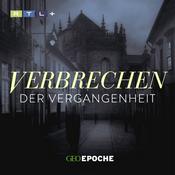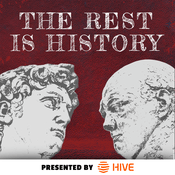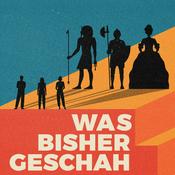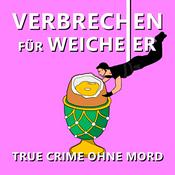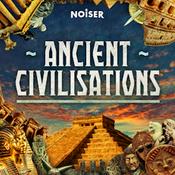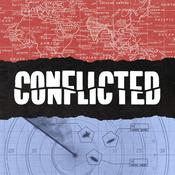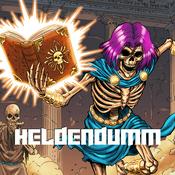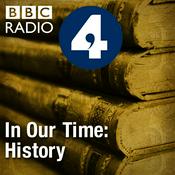2612 Episoden

Walter Harper and the Summiting of Denali, Part 2
17.12.2025 | 39 Min.
The final stages of the expedition to summit Denali were grueling for Walter Harper and the rest of the team. And after that accomplishment, Harper's life was tragically short. Research: Bishop, Click. “Sponsor Statement SB-144 – Walter Harper Day.” Alaska State Legislature. https://www.akleg.gov/basis/get_documents.asp?session=31&docid=58198 Dean, Patrick. “How Hudson Stuck's Ascent of Denali Boosted Recognition of Indigenous Alaskans.” History News Network. 12/13/2020. https://www.hnn.us/article/how-hudson-stucks-ascent-of-denali-boosted-recogni Denali National Park and Preserve. “Superintendent Harry Karstens.” https://www.nps.gov/dena/learn/photosmultimedia/station06a.htm Ehrlander, Mary. “Walter Harper, Alaska Native Son.” UAF Summer Sessions & Lifelong Learning. Via YouTube. 7/7/2018. https://www.youtube.com/watch?v=9-FrvS3gONg Farquhar, Francis P. “Henry P. Karstens—1878-1955.” The American Alpine Club. https://publications.americanalpineclub.org/articles/12195611200/Henry-P-Karstens-1878-1955 Hayes, Alan L. “One Congregation, Two Cultures: St. Mark’s Episcopal Church Nenana, Alaska.” Anglican and Episcopal History, vol. 68, no. 1, 1999, pp. 141–46. JSTOR, http://www.jstor.org/stable/42612013. Accessed 24 Nov. 2025. James, David A. “In story of the legendary ‘Walter Harper: Alaska Native Son,’ Denali is just the beginning.” Alaska Daily News. 12/16/2017. https://www.adn.com/arts/books/2017/12/16/in-story-of-the-legendary-walter-harper-alaska-native-son-denali-is-just-the-beginning/ James, David. “The Brief, But Bright Story of Walter Harper.” Alaska. 5/21/2022. https://alaskamagazine.com/authentic-alaska/the-brief-but-bright-story-of-walter-harper/ John, Peter. “The Gospel According to Peter John.” Krupa, David J., editor. Alaska Native Knowledge Network. 1996. https://ankn.uaf.edu/publications/Books/Peter_John.pdf Johnson, Erik. “Honoring the Unsung Heroes of the 1913 Summit Expedition: Esaias George and John Fredson.” National Park Service. https://www.nps.gov/articles/000/dena-history-unsung-heroes.htm Johnson, Erik. “The Ultimate Triumph and Tragedy: Remembering Walter Harper 100 Years Later.” National Park Service. Denali National Park. https://www.nps.gov/articles/dena-history-harper.htm Manville, Julie and Ross Maller. “The Influence of Christian Missionaries on Alaskan Indigenous Peoples.” Interdisciplinary Journal of Research on Religion. Vol. 5, Article 8. 2009. Miller, Matt. “‘May Light Perpetual Shine Upon Them.’” KTOO. https://www.ktoo.org/2013/10/26/may-light-perpetual-shine-upon-them/ New York Times. “Yukon Indian Opens Coney Island Eyes.” 6/1/1914. Stuck, Hudson. “A winter circuit of our Arctic coast; a narrative of a journey with dog-sleds around the entire Arctic coast of Alaska.” New York. C. Scribner’s Sons. 1920. https://archive.org/details/wintercircuito00stuc/ Stuck, Hudson. “Ten Thousand Miles With A Dog Sled a Narrative of winter travel in Interior Alaska.” 1917. https://archive.org/details/tenthousandmiles0000huds/ Stuck, Hudson. “The ascent of Denali (Mount McKinley) a narrative of the first complete ascent of the highest peak in North America.” New York, C. Scribner's Sons. 1914. https://archive.org/details/ascentofdenalimo01stuc/ Stuck, Hudson. “Voyages on the Yukon and its tributaries: a narrative of summer travel in the interior of Alaska.” New York : Charles Scribner's Sons. 1917. https://archive.org/details/cihm_76545/ Walker, Tom. “A Brief Account of the 1913 Climb of Mount McKinley.” Denali National Park and Preserve. https://www.nps.gov/dena/learn/historyculture/1913ex.htm Woodside, Christine. “Who Led the First Ascent of Denali? Hudson Stuck, Archdeacon of the Yukon.” Vol. 63, No., 2 Summer/Fall 2012. See omnystudio.com/listener for privacy information.

Walter Harper and the Summiting of Denali, Part 1
15.12.2025 | 36 Min.
While working as a guide in his youth, Walter Harper met and worked for a man named Hudson Stuck. Their friendship would lead to Walter becoming the first person to reach the summit of Denali. Research: Bishop, Click. “Sponsor Statement SB-144 – Walter Harper Day.” Alaska State Legislature. https://www.akleg.gov/basis/get_documents.asp?session=31&docid=58198 Dean, Patrick. “How Hudson Stuck's Ascent of Denali Boosted Recognition of Indigenous Alaskans.” History News Network. 12/13/2020. https://www.hnn.us/article/how-hudson-stucks-ascent-of-denali-boosted-recogni Denali National Park and Preserve. “Superintendent Harry Karstens.” https://www.nps.gov/dena/learn/photosmultimedia/station06a.htm Ehrlander, Mary. “Walter Harper, Alaska Native Son.” UAF Summer Sessions & Lifelong Learning. Via YouTube. 7/7/2018. https://www.youtube.com/watch?v=9-FrvS3gONg Farquhar, Francis P. “Henry P. Karstens—1878-1955.” The American Alpine Club. https://publications.americanalpineclub.org/articles/12195611200/Henry-P-Karstens-1878-1955 Hayes, Alan L. “One Congregation, Two Cultures: St. Mark’s Episcopal Church Nenana, Alaska.” Anglican and Episcopal History, vol. 68, no. 1, 1999, pp. 141–46. JSTOR, http://www.jstor.org/stable/42612013. Accessed 24 Nov. 2025. James, David A. “In story of the legendary ‘Walter Harper: Alaska Native Son,’ Denali is just the beginning.” Alaska Daily News. 12/16/2017. https://www.adn.com/arts/books/2017/12/16/in-story-of-the-legendary-walter-harper-alaska-native-son-denali-is-just-the-beginning/ James, David. “The Brief, But Bright Story of Walter Harper.” Alaska. 5/21/2022. https://alaskamagazine.com/authentic-alaska/the-brief-but-bright-story-of-walter-harper/ John, Peter. “The Gospel According to Peter John.” Krupa, David J., editor. Alaska Native Knowledge Network. 1996. https://ankn.uaf.edu/publications/Books/Peter_John.pdf Johnson, Erik. “Honoring the Unsung Heroes of the 1913 Summit Expedition: Esaias George and John Fredson.” National Park Service. https://www.nps.gov/articles/000/dena-history-unsung-heroes.htm Johnson, Erik. “The Ultimate Triumph and Tragedy: Remembering Walter Harper 100 Years Later.” National Park Service. Denali National Park. https://www.nps.gov/articles/dena-history-harper.htm Manville, Julie and Ross Maller. “The Influence of Christian Missionaries on Alaskan Indigenous Peoples.” Interdisciplinary Journal of Research on Religion. Vol. 5, Article 8. 2009. Miller, Matt. “‘May Light Perpetual Shine Upon Them.’” KTOO. https://www.ktoo.org/2013/10/26/may-light-perpetual-shine-upon-them/ New York Times. “Yukon Indian Opens Coney Island Eyes.” 6/1/1914. Stuck, Hudson. “A winter circuit of our Arctic coast; a narrative of a journey with dog-sleds around the entire Arctic coast of Alaska.” New York. C. Scribner’s Sons. 1920. https://archive.org/details/wintercircuito00stuc/ Stuck, Hudson. “Ten Thousand Miles With A Dog Sled a Narrative of winter travel in Interior Alaska.” 1917. https://archive.org/details/tenthousandmiles0000huds/ Stuck, Hudson. “The ascent of Denali (Mount McKinley) a narrative of the first complete ascent of the highest peak in North America.” New York, C. Scribner's Sons. 1914. https://archive.org/details/ascentofdenalimo01stuc/ Stuck, Hudson. “Voyages on the Yukon and its tributaries: a narrative of summer travel in the interior of Alaska.” New York : Charles Scribner's Sons. 1917. https://archive.org/details/cihm_76545/ Walker, Tom. “A Brief Account of the 1913 Climb of Mount McKinley.” Denali National Park and Preserve. https://www.nps.gov/dena/learn/historyculture/1913ex.htm Woodside, Christine. “Who Led the First Ascent of Denali? Hudson Stuck, Archdeacon of the Yukon.” Vol. 63, No., 2 Summer/Fall 2012. See omnystudio.com/listener for privacy information.

SYMHC Classics: Washington Irving
13.12.2025 | 33 Min.
This 2021 episode covers Washington Irving, who is often associated with Halloween. But his writing had a significant influence on the way Christmas is celebrated in the U.S.See omnystudio.com/listener for privacy information.

Behind the Scenes Minis: Raccoon Cranberries
12.12.2025 | 31 Min.
Tracy wonders whether Jack the turkey went to the bathroom in the White House. Holly talks about how much she dislikes people arguing over food preferences. See omnystudio.com/listener for privacy information.

Cranberries
10.12.2025 | 36 Min.
The cranberries we typically eat are native to North America, though they are also grown in other places. How did they become a standard part of the holiday table? Research: Albanese, Ellen. “A brief history of the cranberry—Cape Cod’s most important fruit.” Cape Cod Life. 2016 Annual. https://capecodlife.com/a-brief-history-of-the-cranberry-cape-cods-most-important-fruit/ Banks, Sir Joseph, and Sir Joseph D. Hooker, ed. “Journal of the Right Hon., Sir Joseph Banks, BART., K.B., P.R.S., During Captain Cook’s First Voyage in M.S. Endeavour in 1768-71 To Terra Del Fuego [sic], Otahite, new Zealand, Australia, the Dutch East indies, Etc.” ” London. Macmillan and Co., LTD. 1896. https://library.dbca.wa.gov.au/FullTextFiles/926449.pdf Berman-Vaporis, Irene, et al. “The U.S. cranberry harvest explained in four charts.” National Geographic. Nov. 27, 2019. https://www.nationalgeographic.com/history/article/united-states-cranberry-harvest-explained-charts?loggedin=true&rnd=1764767841856 Blakemore, Erin. “A Brief History of Cranberries.” Smithsonian. Nov. 25, 2015. https://www.smithsonianmag.com/smart-news/brief-history-cranberries-180957399/ Borunda, Alejandro. “Climate change is coming for New England's cranberries.” National geographic. Nov. 25, 2020. https://www.nationalgeographic.com/environment/article/climate-change-affecting-massachusetts-cranberries Chen, Angus. “We Tried A Futuristic Cranberry. It Was Fresh And Naturally Sweet.” NPR. Nov. 24, 2015. https://www.npr.org/sections/thesalt/2015/11/24/457247226/cranberry-you-could-eat-without-sugar “DDT - A Brief History and Status.” Environmental Protection Agency. https://www.epa.gov/ingredients-used-pesticide-products/ddt-brief-history-and-status Eastwood, B. “Complete Manual for the Cultivation of the Cranberry: With a Description of the Best Varieties.” A.O. Moore. 1859. https://archive.org/details/completemanualf00eastgoog/page/n4/mode/2up Henshaw, Tom. “Cranberry Industry Seen Hurt for Years by Weed Killer Scare.” Courir-Post. Nov. 26, 1959. https://www.newspapers.com/image-view/180597557/?match=1&terms=Marcus%20Urann “Historical Timeline of Cranberries.” Massachusetts Cranberries. https://www.cranberries.org/history Josselyn, John. “New-England's rarities discovered in birds, beasts, fishes, serpents, and plants of that country.” Boston. William Veazie. 1865. https://archive.org/details/newenglandsrarit00joss/page/n7/mode/2up “Marcus Urann Scholarship.” Bank of America. https://www.gnbvt.edu/wp-content/uploads/2020/02/Marcus-Urann-Scholarship-.pdf “M. Urann Rites Are Tomorrow.” The Standard-Times. April 5, 1963. https://www.newspapers.com/image-view/1260416770/?match=1&terms=Marcus%20Urann “Our History.” CoBank. https://www.cobank.com/corporate/history Readal, Maryann. “Cranberry – Herb for the Holidays.” The HerbSociety of America Blog. Nov. 7, 2022. https://herbsocietyblog.wordpress.com/tag/elizabeth-lee-ocean-spray/ Smith, K. Annabelle. “How Marcus Urann’s idea revolutionized the cranberry industry.” Smithsonian. Nov. 27, 2013. https://www.smithsonianmag.com/arts-culture/this-man-made-the-first-canned-cranberry-sauce-180947862/ Tennenbaum, David, and Lee Sensenbrenner. “Sprouting a new future for Wisconsin’s red and white.” University of Madison-Wisconsin News. Oct. 29, 2015. https://news.wisc.edu/sprouting-a-new-future-for-wisconsins-red-and-white/ Theobald, Mary Miley. “Bogged Down in Cranberries.” Colonial Williamsburg. https://research.colonialwilliamsburg.org/Foundation/journal/Holiday06/cran.cfm See omnystudio.com/listener for privacy information.
Weitere Geschichte Podcasts
Trending Geschichte Podcasts
Über Stuff You Missed in History Class
Höre Stuff You Missed in History Class, Verbrechen der Vergangenheit und viele andere Podcasts aus aller Welt mit der radio.de-App

Hol dir die kostenlose radio.de App
- Sender und Podcasts favorisieren
- Streamen via Wifi oder Bluetooth
- Unterstützt Carplay & Android Auto
- viele weitere App Funktionen
Hol dir die kostenlose radio.de App
- Sender und Podcasts favorisieren
- Streamen via Wifi oder Bluetooth
- Unterstützt Carplay & Android Auto
- viele weitere App Funktionen


Stuff You Missed in History Class
App laden,
loshören.
